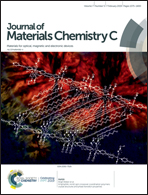Extremely large d0 magnetism in krypton implanted polar ZnO films†
Abstract
Magnetization is produced in samples of ZnO by implanting krypton ions. Krypton is chemically inert; hence, the magnetization is the consequence of the radiation damage that occurred due to the implantation process. We have found magnetization as large as 185 emu cm−3 at room temperature which corresponds to a moment of ∼40 Bohr magnetons per implanted krypton ion. The results are compared for implantation into different ZnO samples, O- and Zn-polar thin films and thin ZnO crystal wafers. The structure of the films has been investigated using RHEED, AFM, XRD and EXAFS. The O-polar film grew in a layer-by-layer mode and after implantation, its lattice spacing increased and the grain size decreased which indicated that the Kr atoms had been incorporated into the lattice. In contrast the Zn-polar film grew in a Stranski–Krastanov mode and its lattice spacing and grain size were almost unchanged by the implantation indicating that the Kr atoms were in the grain boundaries. Raman scattering is used to characterize the radiation damage and to identify scattering from amorphous regions in the grain boundaries and the scattering from point defects. The largest magnetization is found in the O-polar ZnO films where there is a marked grain fragmentation, leading to an increase in the volume of the sample occupied by grain boundaries. The increase in the number of point defects, which was identified by Raman scattering for films of both polarity, was less effective at producing a magnetic signal than the grain boundaries.



 Please wait while we load your content...
Please wait while we load your content...